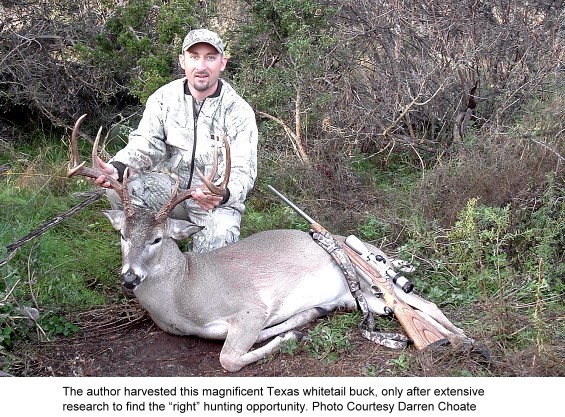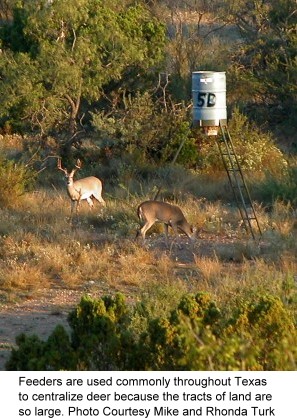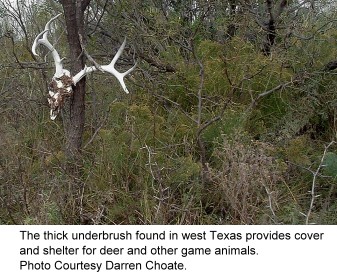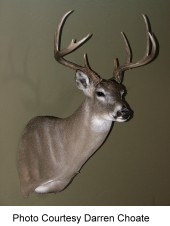
In the pre-dawn hours I made my way to a Texas-style deer stand – a first for me. The stand, a small, wooden building sat on a hill overlooking a brushy, creek-bottom. This was my first White-tailed deer hunt other than the Coues variety found in my home state of Arizona. As a non-resident, I had researched and prepared for this hunt for over six months.
The door creaked as I opened it. I entered and sat in one of the cold, metal chairs. A small eight-point buck was already at the feeder nearby, about 150 yards away from my ambush site. I started to glass the surrounding area with my binoculars when I heard a buck-snort. A quick glance to my left revealed another small buck. The buck crossed my scent left on the trail I had walked in on, and was trying to warn other deer. As I focused my attention on the small buck, it darted off up the hill, away from my position. Over the next few hours I saw a couple does, but no more bucks.
Finally, the sun crept above the horizon, illuminating the dew covered vegetation below; everything was saturated with brilliant colors. At that moment I caught movement in the river-bottom. A second glance confirmed my suspicion, it was a deer. As the deer leaped up the bank onto the flood plain I saw a magnificent set of antlers. The buck was incredibly wide. The rack gleamed in the sunlight, which was visible to the naked eye at a distance of 250 yards. Right away, I knew this was the buck I wanted to harvest!
The buck continued moving my way; adrenaline rushed through me. I tried to take deep breaths, but a case of buck-fever had set in. I raised my rifle and rested the forearm on the sill of the open window. I chambered a round and followed the buck in my scope; hoping, waiting for a chance at a shot. Finally the buck stopped, but the brush was so thick I could not chance the shot. Patiently, I waited for a more promising opportunity. When the buck continued, it moved in my direction, but suddenly cut to my right. If the buck continued on this path it would soon be out of sight. I was worried a shot at the buck would not follow.
 Just as I thought the buck was going to walk out of site forever, it turned and headed back to the left. It appeared that it had caught the scent of a doe, and was head-down, on a beeline towards the feeder where I had seen the smaller, eight-point buck earlier. The buck continued on an even pace directly toward the feeder, which was about 150 yards away. The feeder was situated in a small opening, and was the only area open enough for me to attempt a shot. I re-positioned myself and waited. Just short of the opening the buck paused briefly, and then hurried into the small opening and stopped, quartering towards me slightly. I drew a bead, took a deep breath, let it out slowly, placed the crosshairs just behind the front shoulder, and fired. With my shot, the buck lifted off of his front feet, regained his ground, and bolted into the thick mesquite trees and even thicker underbrush. Stunned, and thinking I had missed, I prepared a story for my cohorts as to why I had missed!
Just as I thought the buck was going to walk out of site forever, it turned and headed back to the left. It appeared that it had caught the scent of a doe, and was head-down, on a beeline towards the feeder where I had seen the smaller, eight-point buck earlier. The buck continued on an even pace directly toward the feeder, which was about 150 yards away. The feeder was situated in a small opening, and was the only area open enough for me to attempt a shot. I re-positioned myself and waited. Just short of the opening the buck paused briefly, and then hurried into the small opening and stopped, quartering towards me slightly. I drew a bead, took a deep breath, let it out slowly, placed the crosshairs just behind the front shoulder, and fired. With my shot, the buck lifted off of his front feet, regained his ground, and bolted into the thick mesquite trees and even thicker underbrush. Stunned, and thinking I had missed, I prepared a story for my cohorts as to why I had missed!
I gave it a few minutes, then, head held low, I hiked down to the spot where the deer had stood when I fired. My investigation of the site uncovered little sign; no blood, no hair, just tracks, so I followed them. I advanced about 50 yards into the thick brush, still following the buck’s tracks in the soft, wet ground, nothing. I stopped to collect my thoughts. As I did, I glanced to my left; there, the buck had perished. I had not missed after all. As it turned out I had made a high-lung hit, thus, very little blood.
I stared in awe. The buck was magnificent! I was proud of my first Texas buck, a main frame eight-point with a small point on his right side. The buck was 20-inches wide and net scored 131 6/8 Boone and Crockett points, making it the 12th largest typical whitetail deer harvested in Region One (west Texas) for that year according to the Texas Big Game Awards. As you can imagine, I spent a lot of time researching hunting locations, outfitters and land-owners leading up to my successful Texas deer hunt. The research takes time, but it is imperative to find a quality hunt.
Researching Texas Hunting Opportunities
 To find the right opportunity for you, first set your criteria. For me, I was looking for a hunting location that included: 1) was within a 10-hour drive of my residence, 2) cost no more than $2000, and 3) was with a reputable outfitter/land-owner. Additionally, I wanted to be able to hunt by myself and incorporate my own hunting tactics. For a couple of weeks I spent countless hours every evening searching online for the right hunting opportunity.
To find the right opportunity for you, first set your criteria. For me, I was looking for a hunting location that included: 1) was within a 10-hour drive of my residence, 2) cost no more than $2000, and 3) was with a reputable outfitter/land-owner. Additionally, I wanted to be able to hunt by myself and incorporate my own hunting tactics. For a couple of weeks I spent countless hours every evening searching online for the right hunting opportunity.
Travel costs can make an affordable hunt, not-so-affordable. I chose to drive for several reasons. First, most hunting locations in Texas are far from the major cities, which requires quite a bit of driving anyway. Second, I would have my vehicle to use while on the hunt. Lastly, for me, the time spent in an airplane to get there would have exceeded my drive time from my residence. In my case, living in southern Arizona, and wanting to drive to the locale, meant hunting in west Texas. If I had been truly motivated by trophy-caliber bucks, I probably would have looked a little further east in the Hill Country or towards south Texas, which is well-known as a trophy hot-spot. Either of these hunts would have exceeded my price limitations I set for myself, however.
The costs of a guided hunt and a lease can be similar; however, there are pros and cons to each. Guided hunts offer the security of having help on your hunt, which can include getting to and from the hunting area, assistance on field-judging animals, and lodging and meals are provided. That said, additional costs such as tips for guides and cooks can increase the overall cost by 10-20 percent. If you choose a guided hunt, verify all fees, such as tips and trophy fees. One major difference between guided hunts and leases is the time which you are allowed to hunt. In most cases, a guided hunt is for three to five days, with additional days available in some cases. A lease is usually good for the entire deer season, and some are good for a full calendar year. Although you will be on your own most of the time, leases provide a challenge that guided hunts do not.
Whichever option you choose, consider the following as well: Some hunts may allow for additional game to be harvested, such as does, javelina, or hogs, which can add to the cost-effectiveness of the hunt. Also, some land-owners/operators do not allow certain activities on their private property such as alcohol on their premises. In either case, set your limit and find a hunt within your budget that meets your style.
In today’s technology age, almost all reputable outfitters and lease providers can be found online, it’s a great place to start. When conducting an Internet search, look for sites that are credible. You can usually establish this by verifying that the website lists the following: 1) current contact information, 2) photos and/or testimonials from previous hunts, and 3) provides a basic fee schedule. During my search one of the best outfitter websites I found was Adobe Lodge based out of San Angelo, TX. There website can be accessed at: https://www.adobelodgephotos.com. After any initial investigation online, call and talk with the owner, and references to become as comfortable as possible with your choice.
 Ultimately, my search led me to choose a lease on the historic Turk Ranch. Located in Terrell County, TX, Turk Ranch is a family-oriented ranch and is operated by Mike and Rhonda Turk. The ranch encompasses approximately 8800 acres and has “encouraged a healthy trophy management plan since the mid1970s.” After communicating with Mike via email and on the phone, my decision was final. The lease option I chose was a year-long lease that came in under my $2000 cap. I purchased a year-round lease and, as you know, harvested a trophy deer.
Ultimately, my search led me to choose a lease on the historic Turk Ranch. Located in Terrell County, TX, Turk Ranch is a family-oriented ranch and is operated by Mike and Rhonda Turk. The ranch encompasses approximately 8800 acres and has “encouraged a healthy trophy management plan since the mid1970s.” After communicating with Mike via email and on the phone, my decision was final. The lease option I chose was a year-long lease that came in under my $2000 cap. I purchased a year-round lease and, as you know, harvested a trophy deer.
Texas in My Rear-view Mirror
 Having grown-up in the West hunting public land, thinking about Texas deer hunting opportunities may be complex and confusing. However, my hunt was truly memorable, and the whitetail mount that hangs on the wall of my den reminds me of my Texas deer hunt on a daily basis. Since my first hunt in Texas, I have returned several times, and I intend on going back soon. If you are looking for new or challenging hunting opportunities, I encourage you to give Texas a try as well.
Having grown-up in the West hunting public land, thinking about Texas deer hunting opportunities may be complex and confusing. However, my hunt was truly memorable, and the whitetail mount that hangs on the wall of my den reminds me of my Texas deer hunt on a daily basis. Since my first hunt in Texas, I have returned several times, and I intend on going back soon. If you are looking for new or challenging hunting opportunities, I encourage you to give Texas a try as well.
About the Author
Happily married, Darren and his wife have two wonderful sons, and make their home in northern Arizona. Darren is a life member and active volunteer of the Rocky Mountain Elk Foundation, and supports several other conservation organizations as well. Although he lives in Elk and Coues country, he enjoys hunting across the country.
Darren is passionate about hunting, and shares that passion with others. His articles have appeared in the Arizona Deer Times, Western Hunter, and Rocky Mountain Game and Fish magazines.“Life is about hunting! My life is my family, friends, and hunting! Hunting with my family and friends is my life!” – Darren Choate
“My First Trip to Texas: A guide for the non-resident hunter” © Darren Choate. All Electronic rights, Real Guns. Inc. Photos appearing with permission of respective copyright holder as noted.

Email Notification